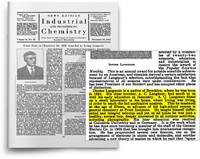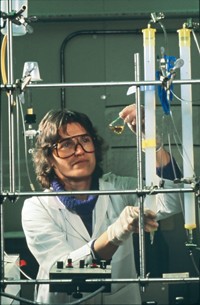Advertisement
Grab your lab coat. Let's get started
Welcome!
Welcome!
Create an account below to get 6 C&EN articles per month, receive newsletters and more - all free.
It seems this is your first time logging in online. Please enter the following information to continue.
As an ACS member you automatically get access to this site. All we need is few more details to create your reading experience.
Not you? Sign in with a different account.
Not you? Sign in with a different account.
ERROR 1
ERROR 1
ERROR 2
ERROR 2
ERROR 2
ERROR 2
ERROR 2
Password and Confirm password must match.
If you have an ACS member number, please enter it here so we can link this account to your membership. (optional)
ERROR 2
ACS values your privacy. By submitting your information, you are gaining access to C&EN and subscribing to our weekly newsletter. We use the information you provide to make your reading experience better, and we will never sell your data to third party members.
People
Of Chemical Weapons And C&EN Talks
by Bibiana Campos Seijo
February 23, 2015
| A version of this story appeared in
Volume 93, Issue 8
“The release of poison gas 100 years ago changed the face of World War I and gave humanity a new weapon of mass destruction.” This is how our special report by Senior Editor Sarah Everts starts. April 22, 2015, marks the centenary of the first chlorine gas attack, the first large-scale use of chemical weapons. C&EN has prepared a multifaceted print and online package to remember this event; the print feature opens on page 8, and the microsite, which includes further coverage as well as a quiz to test your knowledge, is at http://cenm.ag/chemweapons.
The brains behind this first attack was Fritz Haber, the German chemist who received the Nobel Prize in Chemistry in 1918 “for the synthesis of ammonia from its elements.” Haber’s discovery was improved upon by Carl Bosch and became the first industrially viable method of synthesizing ammonia from nitrogen and hydrogen gases, an invention of great importance for the preparation of fertilizers. The Haber-Bosch process is still the workhorse for fertilizer manufacturing to the extent that nowadays, food production for half the world’s population depends on this method of production.
Haber was also the man behind turning toxic compounds, such as chlorine, phosgene, and mustard gas, into weapons of war. Consequently, in addition to being known for his role in feeding the world’s population, he is also remembered in history as “the father of chemical warfare.”
I was interested to learn that Haber had to fight the skepticism of the German High Command to test the weapon. At the time, both Germany and the Allies were able to efficiently mass-produce weapons that could kill at close range, including hand grenades and shell artillery. He had argued that chemical weapons could speed up the war and end it in a matter of months. He was wrong, and the German Army set a precedent that could not be undone.
Many of the historical pictures in this special report are very striking, very sobering. As are the passages from two soldiers who were part of that April 22 attack. C&EN is not celebrating the centennial of this use of chemistry, we are marking the anniversary in a way that, we believe, respects the gravity of this event and what has grown from it.
If you would like to explore this topic further you can attend a presentation that Sarah will be giving as part of the technical program at the upcoming 249th ACS National Meeting, in Denver. The Division of the History of Chemistry is organizing a session titled “Modern Chemical Warfare: History, Chemistry, Toxicology & Morality,” which will be dedicated to the chemical weapons centennial. Sarah will give a talk on Haber and his legacy on Tuesday, March 24, at 8:35 AM.
Award for The Safety Zone
I also wanted to share with you that C&EN Senior Editor Jyllian Kemsley has been awarded the ACS Division of Chemical Health & Safety (CHAS) Howard Fawcett Award. The award is presented annually for outstanding contributions to the science, technology, education, and communication of chemical health and safety, and this year CHAS has decided to present this award to Jyllian (and the C&EN staff) “for her outstanding efforts in communication.”
Jyllian is responsible for The Safety Zone (http://cenm.ag/safetyzone), our blog that covers chemical safety issues in academic and industrial research labs and in manufacturing. It is intended to be a forum for exchange and discussion of lab and plant safety and accident information. It is written primarily by Jyllian, and it includes contributions from other C&EN staff writers and safety experts in academia, industry, and government.
As part of the award, Jyllian will give a presentation at the CHAS award symposium during the 250th ACS National Meeting, in Boston. If you are planning to go, please put Jyllian’s presentation on your must-do list.
Views expressed on this page are those of the author and not necessarily those of ACS.




Join the conversation
Contact the reporter
Submit a Letter to the Editor for publication
Engage with us on Twitter